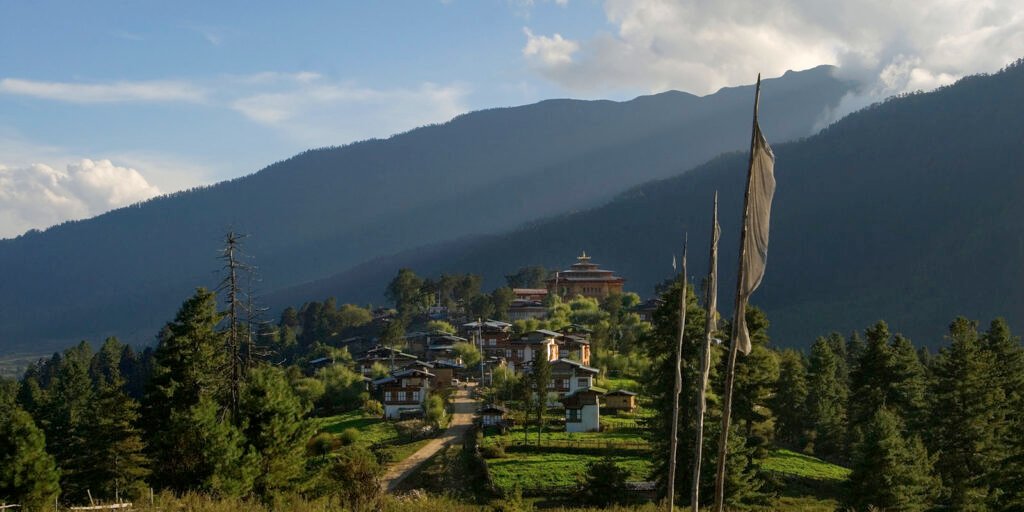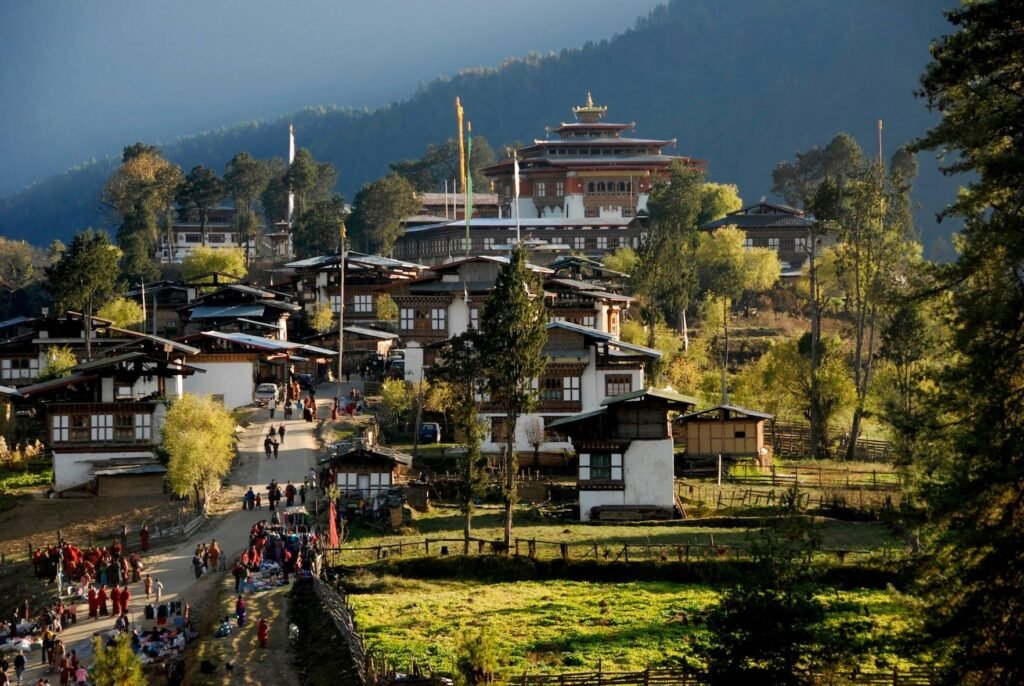Gangtey
Timeout Bhutan Travel – Your Best Travel Partner in Bhutan
Exploring Gangtey Valley in Bhutan
This picturesque valley, also known as Phobjikha Valley, is a sanctuary of tranquility and natural beauty, offering visitors a glimpse into the rich cultural heritage and biodiversity of Bhutan. Join us on a journey as we uncover the enchanting allure of Gangtey.

Gangtey Valley is renowned for its breathtaking natural beauty, characterized by rolling hills, lush forests, and pristine alpine meadows. Surrounded by snow-capped peaks and dotted with traditional Bhutanese farmhouses, the valley exudes a sense of serenity and timelessness, inviting visitors to immerse themselves in the tranquility of the countryside.
At the heart of Gangtey Valley stands the majestic Gangtey Monastery, a revered Buddhist institution that dates back to the 17th century. Perched on a hill overlooking the valley, the monastery offers panoramic views of the surrounding landscape and serves as a spiritual sanctuary for monks and pilgrims alike. Visitors can explore the monastery’s ornate prayer halls, intricate murals, and sacred relics, gaining insight into Bhutan’s rich religious heritage.
Gangtey Valley is also home to the annual winter migration of the endangered black-necked cranes, a spectacle that attracts birdwatchers and nature enthusiasts from around the world. The Black-Necked Crane Conservation Center, located in the heart of the valley, offers visitors a unique opportunity to learn about these majestic birds and their conservation efforts in Bhutan.
For outdoor enthusiasts, Gangtey Valley offers a plethora of trekking and hiking opportunities amidst breathtaking scenery. Alternatively, venture into the nearby Phobjikha Nature Reserve, home to a diverse array of flora and fauna.

Gangtey Valley provides a rare opportunity to experience traditional Bhutanese culture and way of life. Visitors can interact with local farmers, participate in traditional farm activities such as milking cows and harvesting crops, and sample authentic Bhutanese cuisine prepared with fresh, locally sourced ingredients.
In Gangtey Valley, time seems to stand still as you wander through idyllic landscapes, explore ancient monasteries, and connect with the warmth and hospitality of the local people. Whether you seek spiritual enlightenment, natural beauty, or cultural immersion, Gangtey promises an unforgettable journey into the heart and soul of Bhutan.



Where the whispers of ancient monasteries echo through pristine landscapes.

Must-Visit Areas in Gangtey
Gangtey Monastery (Gangtey Gonpa): This 17th-century monastery is perched atop a hill overlooking the valley and is one of the main attractions in Gangtey. Visitors can explore the monastery’s intricate architecture, ornate prayer halls, and stunning views of the surrounding countryside.
Black-Necked Crane Conservation Center: Gangtey Valley is a crucial habitat for the endangered black-necked cranes, which migrate here during the winter months. The conservation center offers visitors a chance to learn about these majestic birds and their conservation efforts through informative exhibits and observation decks.
Phobjikha Nature Reserve: This protected area is home to a diverse range of flora and fauna, including rare species like the Himalayan black bear, red panda, and leopard. Visitors can explore the nature reserve through various hiking trails, which offer opportunities for wildlife spotting and birdwatching.
Gangtey Goenpa Nature Trail: This scenic walking trail meanders through the picturesque countryside surrounding Gangtey Monastery. Along the way, visitors can enjoy panoramic views of the valley, encounter local wildlife, and experience the tranquility of rural Bhutan.
Gangtey Village: Exploring the charming village of Gangtey offers visitors a glimpse into traditional Bhutanese life. Visitors can wander through the village’s narrow lanes, admire the traditional architecture of the houses, and interact with friendly locals.
Dongkala Village: This quaint village is known for its traditional Bhutanese architecture and serene surroundings. Visitors can stroll through the village, visit local temples and monasteries, and enjoy the peaceful atmosphere of rural Bhutan.
Bjoka Village: Located on the outskirts of Gangtey Valley, Bjoka Village is famous for its annual Naked Dance Festival, which celebrates the harvest season and local agricultural traditions. Visitors can experience the vibrant culture of Bhutan through traditional music, dance, and rituals.
Bongchu Tsho: This sacred lake is located near Gangtey Monastery and is considered a spiritual site by the locals. Visitors can enjoy a peaceful walk around the lake, take in the serene surroundings, and pay homage to the local deities.

WHAT WE DO
- Customize Authentic vacations
- Go above and beyond
- Put your best interests first
- Expect exceptional reviews
- Value relationships
- Exceed expectations
- Find those hidden gems
WHAT WE DON'T DO
- We don’t customize Cookie-cutter travel
- We don’t sacrifice quality for profit
- We don’t overpromise
- We are not inflexible
- We are not the same as everyone else
- We don’t act closed-minded
- We don’t lack imagination
Latest Blogs
FAQs for Your Bhutan Tour Adventure
The currency of Bhutan is the Ngultrum (BTN). Indian Rupees are also accepted in Bhutan, but notes of 2,000, 500, and 200 are not commonly accepted. It’s advisable to carry cash, as ATMs might not be widely available, especially in rural areas, and not all places accept credit cards.
Bhutan is considered one of the safest countries for tourists.
It’s recommended to consult with a healthcare provider for vaccinations and health advice at least 4 to 6 weeks before your trip.
Respect local traditions and dress modestly, especially when visiting religious sites. Always ask permission before taking photographs of people or religious icons. It’s also customary to remove your shoes before entering temples and some homes.
Yes, attending a Tshechu (religious festival) is a highlight of visiting Bhutan.
Due to the limited number of tourists allowed to enter Bhutan and the need to arrange visas and travel permits, it’s advisable to plan your trip at least 3 to 6 months in advance, especially if you’re planning to visit during the high season or attend a popular festival.
Travel within Bhutan is usually arranged by your tour operator, including private vehicles for transportation between cities and to tourist sites. For trekking tours, transportation of equipment is typically handled by yaks or horses, with guides leading the way.
Contact Us
Don’t hesitate to contact us for any quotes or sample itineraries. We’re here, happy and ready to serve you in every way possible.
Follow Us
- Motithang: Thimphu
- +975 17 11 38 18
- timeoutbhutan@gmail.com
